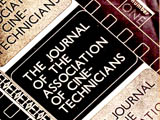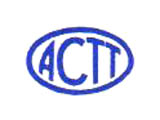
 |
 | ACTAssociation of Cine Technicians (1933-1956)ACTTAssociation of Cinematograph & Television Technicians (1956-1991) |  |
||
|
The Association of Cine-Technicians was formed in June 1933 and became the Association of Cinematograph, Television and allied Technicians in March 1956, two years after the introduction of commercial television. In 1991, with membership falling, it merged with BETA (Broadcasting and Entertainment Trades Alliance) to become BECTU, the Broadcasting Entertainment Cinematograph and Theatre Union. The first organisation to represent the interests of British film technicians was The Cameramen's Society, formed after the end of the First World war in 1918, with Harry Wiggins (father of Helen Wiggins) as Chairman and George Woods-Taylor as Secretary. It was more of a social club than a union, but in 1926, when film production in the UK had virtually ground to a halt, it managed to help influence the Cinematograph Films Act (1927). It would have had more weight had it not lost its funds in the Farrow's Bank crash in December 1920. In 1928 the British Association of Cinematographers and Associated Technicians was formed "and found ready adherents in the ranks of camera artists, art directors, chiefs of laboratories, lighting experts and scenic artists. The object of the Society is the study of kinematography and the professional protection of its members" [Kinematograph Year Book 1929]. Unfortunately this attempt at unionisation subsequently collapsed when the Treasurer ran off with the funds. By the start of the 1930s the British film industry was booming, but the wages of film technicians remained relatively low and the hours long. An increase in immigration, with many leaving Germany after Hitler was appointed Chancellor at the beginning of 1933, left British workers fearing that their jobs were under threat. Technicians at the Gaumont-British studio at Shepherds Bush started holding meetings, culminating in the establishment of the ACT in June. The initial membership, with an entrance fee of 2/6d (equivalent to £8 in 2015) peaked at around 1,200, but a perceived lack of activity led to disillusionment, and membership rapidly dwindled. By the end of the year there were less than 100 members, many of them not fully paid-up. In 1934 George Elvin was elected General Secretary, and he threw himself into rebuilding the membership to a point where employers would have to recognise the union. In May 1935 the ACT began publication of a quarterly magazine, The Cine-Technician, priced at 9d (equivalent to £2.38 in 2015). In 1957 it became The Film & Television Technician, and in 1992, after the formation of BECTU, it changed to it's current title of Stage Screen & Radio. In 1936 the ACT became affiliated to the TUC, and achieved its first industrial agreement, with Gaumont-British. It also recruited Film Laboratory workers, establishing a branch that could be used to bring industrial pressure to bear on rogue producers. In the Spring of 1943 the ACT published rates for Animation: Cartoon, Diagram and Rostrum Camera Section. Agreement has been reached with Mr. Hopkins, Cartoon Key Artist or Animator . . . . . . . . . .£10 0 0 Not less than 50% of In-Betweeners and Tracers Diagram Department Diagram Artist (able to plan his own Title Department These rates apply only where technicians are Camera Department Rostrum Cameraman (able to photo- |
||||
|
The following year they negotiated an Agreement with Halas and Batchelor Cartoon Films, which had just relocated from Bushey to 10a Soho Square. The July 1944 issue of The Cine-Technician announced: First "Closed Shop" Agreement Agreement has been reached between Halas- Batchelor Cartoon Films and our Association. The company is one of the pioneers in the making of cartoon films in this country and is actively engaged on work for the Fighting Forces. The Agreement provides that all employees of the company shall be members of A.C.T. This is the first time in our history that we have estab- lished the "Closed Shop" principle in an agree- ment. The general conditions of employment by the company are covered by the Shorts Film Standard Agreement. We append herewith the schedule of minimum wage rates : Per 47-hour week Key Artists or Animator (capable of action planning from the script). . . Animator (not responsible for action planning) . . .. . .. . .. . . Background Artist . . .. . .. . . In-Betweeners: Grade I . . .. . . Grade II. . .. . . Tracers: Grade I . . .. . .. . . Grade II . . .. . .. . . Not less than 50% of In-Betweeners and Tracers employed by the Company shall be Grade I Supervisor of Colourists. . .. . . Colourists . . .. . .. . .. . . Rostrum Cameraman (able to photo- graph Diagram Cartoons, etc.). . . Assistant Cameraman . . .. . .. . . £ s. d. To these, of course, must be added the cost-of- living bonus payable under the Shorts Film Stan- dard Agreement. In addition to Halas Batchelor we hold simi- lar agreements for the Animation and Diagram sections of the Industry with Publicity Picture Productions, British Industrial Films and Techni- color Ltd. The rates are as per the agreement with Publicity Picture Productions, but Halas and Batchelor negotiated two additional grades, "Animator (not responsible for action planning)" – an assistant animator, or one working under a directing animator – and "Supervisor of Colourists" – cel-painters being the lowest grade, the supervisor presumably checks the quality, as well as distributing the work and ensuring that the painters are familiar with the colour model and are given the correct paints.
|
Links to Other Sites | ||||
Peter Hale
Last updated 2025
|